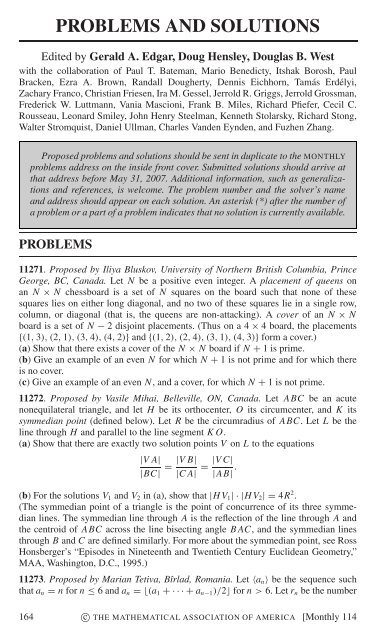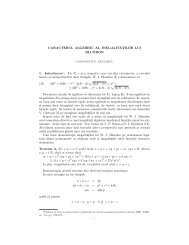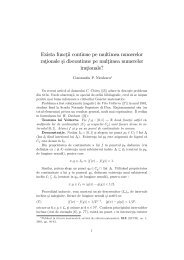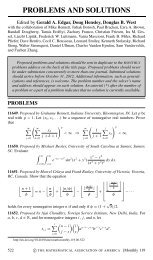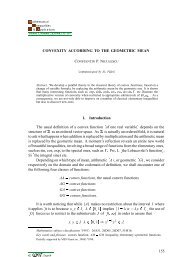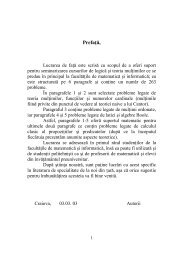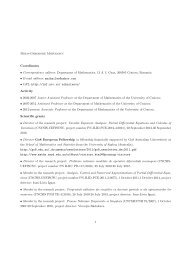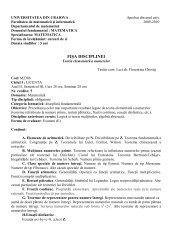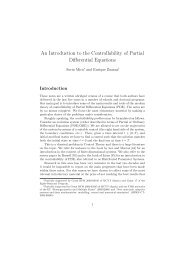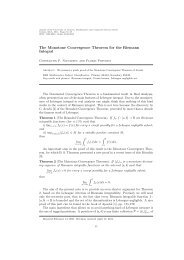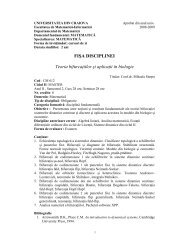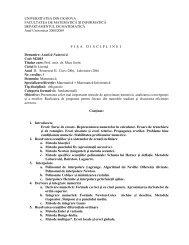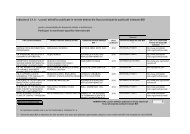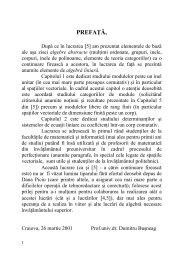PROBLEMS AND SOLUTIONS
PROBLEMS AND SOLUTIONS
PROBLEMS AND SOLUTIONS
Create successful ePaper yourself
Turn your PDF publications into a flip-book with our unique Google optimized e-Paper software.
<strong>PROBLEMS</strong> <strong>AND</strong> <strong>SOLUTIONS</strong><br />
Edited by Gerald A. Edgar, Doug Hensley, Douglas B. West<br />
with the collaboration of Paul T. Bateman, Mario Benedicty, Itshak Borosh, Paul<br />
Bracken, Ezra A. Brown, Randall Dougherty, Dennis Eichhorn, Tamás Erdélyi,<br />
Zachary Franco, Christian Friesen, Ira M. Gessel, Jerrold R. Griggs, Jerrold Grossman,<br />
Frederick W. Luttmann, Vania Mascioni, Frank B. Miles, Richard Pfiefer, Cecil C.<br />
Rousseau, Leonard Smiley, John Henry Steelman, Kenneth Stolarsky, Richard Stong,<br />
Walter Stromquist, Daniel Ullman, Charles Vanden Eynden, and Fuzhen Zhang.<br />
Proposed problems and solutions should be sent in duplicate to the MONTHLY<br />
problems address on the inside front cover. Submitted solutions should arrive at<br />
that address before May 31, 2007. Additional information, such as generalizations<br />
and references, is welcome. The problem number and the solver’s name<br />
and address should appear on each solution. An asterisk (*) after the number of<br />
a problem or a part of a problem indicates that no solution is currently available.<br />
<strong>PROBLEMS</strong><br />
11271. Proposed by Iliya Bluskov, University of Northern British Columbia, Prince<br />
George, BC, Canada. Let N be a positive even integer. A placement of queens on<br />
an N × N chessboard is a set of N squares on the board such that none of these<br />
squares lies on either long diagonal, and no two of these squares lie in a single row,<br />
column, or diagonal (that is, the queens are non-attacking). A cover of an N × N<br />
board is a set of N − 2 disjoint placements. (Thus on a 4 × 4 board, the placements<br />
{(1, 3), (2, 1), (3, 4), (4, 2)} and {(1, 2), (2, 4), (3, 1), (4, 3)} form a cover.)<br />
(a) Show that there exists a cover of the N × N board if N + 1isprime.<br />
(b) Give an example of an even N for which N + 1 is not prime and for which there<br />
is no cover.<br />
(c) Give an example of an even N, and a cover, for which N + 1 is not prime.<br />
11272. Proposed by Vasile Mihai, Belleville, ON, Canada. Let ABC be an acute<br />
nonequilateral triangle, and let H be its orthocenter, O its circumcenter, and K its<br />
symmedian point (defined below). Let R be the circumradius of ABC.LetL be the<br />
line through H and parallel to the line segment KO.<br />
(a) Show that there are exactly two solution points V on L to the equations<br />
|VA|<br />
|BC| = |VB|<br />
|CA| = |VC|<br />
|AB| .<br />
(b) For the solutions V 1 and V 2 in (a), show that |HV 1 |·|HV 2 |=4R 2 .<br />
(The symmedian point of a triangle is the point of concurrence of its three symmedian<br />
lines. The symmedian line through A is the reflection of the line through A and<br />
the centroid of ABC across the line bisecting angle BAC, and the symmedian lines<br />
through B and C are defined similarly. For more about the symmedian point, see Ross<br />
Honsberger’s “Episodes in Nineteenth and Twentieth Century Euclidean Geometry,”<br />
MAA, Washington, D.C., 1995.)<br />
11273. Proposed by Marian Tetiva, Bîrlad, Romania. Let 〈a n 〉 be the sequence such<br />
that a n = n for n ≤ 6anda n =⌊(a 1 +···+a n−1 )/2⌋ for n > 6. Let r n be the number<br />
164 c○ THE MATHEMATICAL ASSOCIATION OF AMERICA [Monthly 114
in {0, 1, 2} congruent to ∑ n<br />
k=1 a k modulo 3. Show that for n ≥ 6, {a 1 ,... ,a n }\{r n }<br />
may be partitioned into three subsets with equal sum. (For example, with n = 7,<br />
{2, 3, 4, 5, 6, 10} ={2, 3, 5}∪{4, 6}∪{10}.)<br />
11274. Proposed by Donald Knuth, Stanford, CA. Prove that for nonnegative integers<br />
m and n,<br />
m∑<br />
k=0<br />
( ) 2m − k<br />
2 k = 4 m −<br />
m + n<br />
n∑<br />
j=1<br />
( ) 2m + 1<br />
.<br />
m + j<br />
11275. Proposed by Michael S. Becker, University of South Carolina at Sumter, Sumter,<br />
SC. Find<br />
∫ ∞ ∫ ∞<br />
y=0<br />
x=y<br />
(x − y) 2 log((x + y)/(x − y))<br />
xysinh(x + y)<br />
dx dy.<br />
11276. Proposed by Eugene Herman, Grinnell College, Grinnell, IA. Let T 1 ,... ,T n<br />
be translations in R 3 with translation vectors t 1 ,... ,t n ,andletR be a rotational linear<br />
transformation on R 3 that rotates space through an angle of π/n about an axis parallel<br />
to a vector r. Define a transformation C by C = (RT n ···RT 2 RT 1 ) 2 . Prove that C is<br />
a translation, find an explicit formula for its translation vector in terms of r, n, and<br />
t 1 ,... ,t n , and prove that there is a line l in R 3 , independent of t 1 ,... ,t n , such that C<br />
translates space parallel to l.<br />
<strong>SOLUTIONS</strong><br />
Exponential Growth of a Solution<br />
11137 [2005, 181]. Proposed by Vicenţiu Rădulescu, University of Craiova, Romania.<br />
Let φ be a continuous positive function on the open interval (A, ∞), and assume that<br />
f is a C 2 -function on (A, ∞) satisfying the differential equation<br />
f ′′ (t) = (1 + φ(t)( f 2 (t) − 1)) f (t).<br />
(a) Given that there exists a ∈ (A, ∞) such that f (a) ≥ 1and f ′ (a) ≥ 0, prove that<br />
there is a positive constant K such that f (x) ≥ Ke x whenever x ≥ a.<br />
(b) Given instead that there exists a ∈ (A, ∞) such that f ′ (a) 1if<br />
x > a, prove that there exists a positive constant K such that f (x) ≥ Ke x whenever<br />
x ≥ a.<br />
(c) Given that f is bounded on (A, ∞) and that there exists α>0suchthatφ(x) =<br />
O(e −(1+α)x ), prove that lim x→∞ e x f (x) exists and is finite.<br />
Solution by Richard Stong, Rice University, Houston, TX.<br />
(a)Letb = inf{t ≥ a : f (t)
Hence in particular ( f ′ (t)) 2 ≥ f 2 (t) − f 2 (a) for t ≥ a. Rewriting this in the form<br />
f ′ (t)/ √ f 2 (t) − f 2 (a) ≥ 1 and integrating over [a, x] gives cosh −1 ( f (x)/f (a)) ≥<br />
x − a, or f (x) ≥ f (a) cosh(x − a) ≥ e x f (a)/(2e a ) for t ≥ a. Hence f satisfies the<br />
required inequality with K = f (a)/(2e a ).<br />
(b) We prove a stronger result, assuming only that f (x) ≥ 1forx ≥ a. Thatis,we<br />
allow equality and do not require that f ′ (a) a with f ′ (c) ≥ 0. Applying part (a) tox ≥ c shows<br />
that there is a constant K 1 > 0suchthat f (x) ≥ K 1 e x for x ≥ c. Continuity and positivity<br />
of f on [a, c] shows there is a constant K 2 > 0 such that f (x) ≥ K 2 e x on [a, c]<br />
and hence K = min(K 1 , K 2 ) suffices for [a, ∞).<br />
(c) Applying part (a) and our version of (b) to f and − f shows that if f is bounded,<br />
then | f | cannot cross from smaller than 1 to at least 1, and cannot remain forever<br />
at least 1. Thus there is some d with | f (x)| < 1forx ≥ d. Choosing d larger, if<br />
necessary, we may assume φ(x) d we claim: if<br />
f (r) >0, then f ′ (r) d with f (r) >0and f ′ (r) ≥ 0. Let s = inf{t ≥<br />
r : f (t) 0, so f ′ (t) ≥ 0 on some interval<br />
[s, s + ɛ).Also f (t) ≥ 0 on this interval, which contradicts the definition of s.<br />
Therefore s =∞, i.e., f (t) ≥ 0and f ′ (t) ≥ 0forallt ≥ r. It follows from the differential<br />
equation that f ′′ (t) ≥ 0, and hence that f and f ′ are nondecreasing on [r, ∞).<br />
It follows that f , f ′ ,and f ′′ are strictly positive on (r, ∞) and hence f is unbounded,<br />
a contradiction.<br />
Thus f and f ′ always have opposite signs. Since f is not eventually zero, and f<br />
can never leave zero, f is never zero.<br />
Without loss of generality, we may assume f (t) >0and f ′ (t) 0on[d, ∞), and hence f ′ is increasing. Thus lim t→∞ f ′ (t)<br />
exists; since f is bounded, the limit must be zero. Similarly, lim t→∞ f ′′ (t) exists (it<br />
equals lim t→∞ f (t)); since f ′ is bounded, this limit must be zero.<br />
The differential equation gives f ′′ (t) = f (t) − φ(t) f (t)(1 − f 2 (t)) < f (t).<br />
Hence (since f ′ < 0) we have 2 f ′ (t) f ′′ (t) >2 f (t) f ′ (t). Integrating over [x, ∞)<br />
gives ( f ′ (x)) 2 < f 2 (x) or 0 > f ′ (x) >− f (x). Hence (e x f (x)) ′ = e x ( f ′ (x) +<br />
f (x)) > 0. Thus e x f (x) is an increasing function of x.<br />
Let K be a constant with φ(t) (1 − φ(t)) f (t),<br />
2 f ′ (t) f ′′ (t) 1 − B, sothisgives<br />
x<br />
f ′ (x)
A Quadrature on a Sphere<br />
11159 [2005, 567]. Proposed by George Lamb, Tucson, AZ. For |a|
Let C = max(a, b).Givenk ∈ S, we claim that there exists m ∈ S with k < m ≤ k +<br />
C. Indeed, there exists j ∈ Z with α
(a) Prove that if n = 2 then the maximum of f is attained for a unique configuration<br />
(up to a rotation) that consists of two points symmetric with respect to the origin.<br />
(b) Prove that if n = 3 then the maximal configuration for f is also unique (up to a<br />
rotation) and consists of three points arranged as the vertices of an equilateral triangle<br />
centered at the origin.<br />
Solution by Microsoft Research Problems Group, Redmond, WA. Observe |z j − z k | 2 +<br />
(1 −|z j | 2 )(1 −|z k | 2 ) = 1 − z j z k − z k z j +|z j | 2 |z k | 2 =|1 − z j z k | 2 . We can rewrite<br />
f (z 1 ,... ,z n ) =<br />
n∏<br />
|z j | 2n( 1 −|z j | 2) ·<br />
j=1<br />
∏<br />
1≤ j
Combining all these bounds, we get<br />
( ) 2nR<br />
f (z 1 , ··· , z n ) ≤ (R n ) 2n (1 − R 2 ) n 2 n(n−1)/2 ) n(n−1)/2<br />
(1 + 2R2<br />
n − 1<br />
n − 1 + R4<br />
( ( ) 2n (n−1)/2 ) (n−1)/2<br />
) n<br />
=<br />
R 3n−1 (1 − R 2 )<br />
(1 + 2R2<br />
n − 1<br />
n − 1 + R4 .<br />
Equality can occur only if r 1 =···=r n = R, z 1 +···+z n = 0, and all |z j − z k | 2 for<br />
j ̸= k are equal.<br />
For (a), where n = 2, the bound simplifies to<br />
f (z 1 , z 2 ) 1/2 ≤ 2R 5 (1 − R 2 )(1 + 2R 2 + R 4 ) 1/2 = 2R 5 (1 − R 4 ).<br />
The right side attains its maximum at R = R max := (5/9) 1/4 . Equality implies r 1 =<br />
r 2 = R max and z 1 + z 2 = 0. The maximum value 2 6 5 5/2 /3 9 of f is achieved when<br />
|z 1 |=R max and z 2 =−z 1 .<br />
For (b), where n = 3, the bound simplifies to<br />
f (z 1 , z 2 , z 3 ) 1/3 ≤ 3R 8 (1 − R 2 )(1 + R 2 + R 4 ) = 3R 8 (1 − R 6 ).<br />
The right side attains its maximum at R = R max = (4/7) 1/6 . The maximum value<br />
√<br />
2 8 3 6 /7 7 of f is achieved when z 1 , z 2 , z 3 form an equilateral triangle of side R max 3<br />
centered at the origin—such a triple is in the domain of f . Any maximum requires<br />
z 1 + z 2 + z 3 = 0, so these are the only maxima.<br />
Editorial comment. The proposer notes that W (z 1 , ··· , z n ) =−π log f (z 1 , ··· , z n )<br />
is the renormalized Ginzburg–Landau energy corresponding to the open set ={z ∈<br />
C: 0 < |z| < 1}. See F. Bethuel, H. Brezis, F. Hélein, Ginzburg–Landau Vortices,<br />
Birkhäuser, Boston, 1994.<br />
Also solved by D. R. Bridges, L. Zhou, and the proposer.<br />
A Functional Equation with Exponential Solutions<br />
11180 [2005, 839]. Proposed by Suat Namli, Louisiana State University, Baton Rouge,<br />
LA. Find all real-valued functions f defined on some interval I about the origin by a<br />
power series having all coefficients nonzero and possessing the property that for all<br />
real s and t there exist constants A s,t , B s,t ,andC s,t such that whenever sx, tx,and<br />
(s + t)x lie in I ,<br />
f (sx) f (tx) = A s,t f (sx) + B s,t f (tx) + C s,t f ((s + t)x).<br />
Solution by O. P. Lossers, Eindhoven University of Technology, Eindhoven, The<br />
Netherlands. We use only the assumptions that f has a power series around x = 0,<br />
f (0) ̸= 0, f ′ (0) ̸= 0 and that the functional equation holds when s = t = 1:<br />
f 2 (x) = af(x) + bf(2x).<br />
Now b ̸= 0, for otherwise f would be a constant function. Taking x = 0, we have<br />
f (0) ( f (0) − a − b ) = 0, so f (0) = a + b. Differentiating and setting x = 0, we<br />
get f ′ (0) (2 f (0) − a − 2b) = 0, so a = 0and f (0) = b. The functional equation is<br />
f 2 (x) = bf(2x). Leth(x) = log ( f (x)/b ) .Since f (0) = b, alsoh has a power series<br />
expansion around x = 0, and it satisfies 2h(x) = h(2x). From the power series<br />
170 c○ THE MATHEMATICAL ASSOCIATION OF AMERICA [Monthly 114
it follows that 2h (n) (0) = 2 n h (n) (0) for all n. Therefore h (n) (0) = 0foralln ̸= 1, so<br />
h(x) = ux for some constant u. Therefore f (x) = b exp(ux).<br />
Editorial comment. Stephen Gagola proved a variant: If the functional equation holds<br />
only for all real nonzero s and t satisfying s ̸= t, then we can have solutions of the<br />
form f (x) = C(1 − kx) −1 as well as solutions of the form f (x) = Ce kx .<br />
Also solved by D. Beckwith, M. Bello-Hernandez & M. Benito (Spain), R. Chapman (U. K.), K. Dale (Norway),<br />
S. Gagola, E. Herman, T. L. McCoy (Taiwan), R. Stong, X. Wang, Szeged Problem Solving Group<br />
“Fejéntaláltuka” (Hungary), Microsoft Research Problems Group, and the proposer.<br />
Apply Hölder<br />
11202 [2006, 179]. Proposed by Grahame Bennett, Indiana University, Bloomington,<br />
IN. Prove that if 〈a n 〉 is a sequence of positive numbers with ∑ ∞<br />
n=1 a n < ∞, then for<br />
all p in (0, 1)<br />
lim<br />
(<br />
n→∞ n1−1/p a p 1 +···+a ) p 1/p<br />
n = 0.<br />
Solution by Eugene A. Herman, Grinnell College, Grinnell, IA. Define 〈x n 〉 by x n =<br />
(1/n) 1−p (a p 1 +···+a p n ).Since<br />
n 1−1/p (a p 1 +···+a p n )1/p = ((1/n) 1−p (a p 1 +···+a p n ))1/p = x 1/p<br />
n ,<br />
it suffices to show that x n → 0. The Hölder inequality will be applied as follows:<br />
∑<br />
( ) (<br />
1<br />
1−p ∑<br />
a p k<br />
n<br />
≤ k<br />
k<br />
1<br />
n<br />
) 1−p ( ∑<br />
k<br />
a k<br />
) p<br />
.<br />
Given any ɛ>0, choose N such that ∑ ∞<br />
n=N a n


